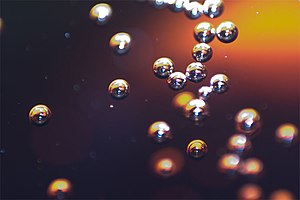Carbonated drink: Difference between revisions
m Reverted edits by 203.251.109.253 (talk) to last version by ClueBot NG |
|||
| Line 9: | Line 9: | ||
{{Div col|colwidth=30em}} |
{{Div col|colwidth=30em}} |
||
* [[Diet Coke and Mentos eruption]] |
* [[Diet Coke and Mentos eruption]] |
||
* [[Fizz keeper]] |
* [[Fizz keeper LIGMA PP]] |
||
* [[Industrial gas]] |
* [[Industrial gas]] |
||
* [[Nitrogenation]] |
* [[Nitrogenation]] |
||
Revision as of 19:24, 26 November 2018

Carbonated drinks are beverages that contain dissolved carbon dioxide. The dissolution of CO2 in a liquid, gives rise to fizz or effervescence. The process usually involves carbon dioxide under high pressure. When the pressure is removed, the carbon dioxide is released from the solution as small bubbles, which causes the solution to become effervescent, or fizzy. A common example is the dissolving of carbon dioxide in water, resulting in carbonated water. Carbon dioxide is only weakly soluble in water, therefore it separates into a gas when the pressure is released.
Carbonated beverages are prepared by mixing flavored syrup with carbonated water, both chilled. Carbonation levels range up to 5 volumes of CO2 per liquid volume. Ginger ale, colas, and related drinks are carbonated with 3.5 volumes. Other drinks, often fruity ones, are carbonated less.[1]
See also
References
- ^ "Beverages, Nonalcoholic", Ullmann's Encyclopedia of Industrial Chemistry, 2000, doi:10.1002/14356007.a04_035
{{citation}}: Cite uses deprecated parameter|authors=(help)
